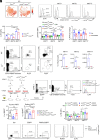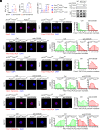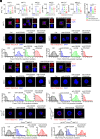iNKT subsets differ in their developmental and functional requirements on Foxo1
- PMID: 34772808
- PMCID: PMC8609641
- DOI: 10.1073/pnas.2105950118
iNKT subsets differ in their developmental and functional requirements on Foxo1
Abstract
Invariant natural killer T (iNKT) cells play important roles in regulating immune responses. Based on cytokine profiling and key transcriptional factors, iNKT cells are classified into iNKT1, iNKT2, and iNKT17 subsets. However, whether the development and functions of these subsets are controlled by distinct mechanisms remains unclear. Here, we show that forkhead box protein O1 (Foxo1) promotes differentiation of iNKT1 and iNKT2 cells but not iNKT17 cells because of its distinct contributions to IL7R expression in these subsets. Nuclear Foxo1 is essential for Il7r expression in iNKT1 and iNKT2 cells at early stages of differentiation but is dispensable in iNKT17 cells. RORγt, instead of Foxo1, promotes IL7R expression in iNKT17 cells. Additionally, Foxo1 is required for the effector function of iNKT1 and iNKT2 cells but not iNKT17 cells. Cytoplasmic Foxo1 promotes activation of mTORC1 in iNKT1 and iNKT2 cells through inhibiting TSC1-TSC2 interaction, whereas it is dispensable for mTORC1 activation in iNKT17 cells. iNKT17 cells display distinct metabolic gene expression patterns from iNKT1 and iNKT2 cells that match their different functional requirements on Foxo1. Together, our results demonstrate that iNKT cell subsets differ in their developmental and functional requirements on Foxo1.
Keywords: Foxo1; TSC2; development; function; iNKT subsets.
Conflict of interest statement
The authors declare no competing interest.
Figures






Similar articles
-
β-Catenin is required for the differentiation of iNKT2 and iNKT17 cells that augment IL-25-dependent lung inflammation.BMC Immunol. 2015 Oct 19;16:62. doi: 10.1186/s12865-015-0121-0. BMC Immunol. 2015. PMID: 26482437 Free PMC article.
-
Transcription factor Bcl11b sustains iNKT1 and iNKT2 cell programs, restricts iNKT17 cell program, and governs iNKT cell survival.Proc Natl Acad Sci U S A. 2016 Jul 5;113(27):7608-13. doi: 10.1073/pnas.1521846113. Epub 2016 Jun 21. Proc Natl Acad Sci U S A. 2016. PMID: 27330109 Free PMC article.
-
SLAM-associated protein favors the development of iNKT2 over iNKT17 cells.Eur J Immunol. 2016 Sep;46(9):2162-74. doi: 10.1002/eji.201646313. Epub 2016 Jul 22. Eur J Immunol. 2016. PMID: 27338553
-
mTOR and its tight regulation for iNKT cell development and effector function.Mol Immunol. 2015 Dec;68(2 Pt C):536-45. doi: 10.1016/j.molimm.2015.07.022. Epub 2015 Aug 4. Mol Immunol. 2015. PMID: 26253278 Free PMC article. Review.
-
Invariant NKT cell development: focus on NOD mice.Curr Opin Immunol. 2014 Apr;27:83-8. doi: 10.1016/j.coi.2014.02.004. Epub 2014 Mar 13. Curr Opin Immunol. 2014. PMID: 24637104 Review.
Cited by
-
Markers and makers of NKT17 cells.Exp Mol Med. 2023 Jun;55(6):1090-1098. doi: 10.1038/s12276-023-01015-y. Epub 2023 Jun 1. Exp Mol Med. 2023. PMID: 37258582 Free PMC article. Review.
References
Publication types
MeSH terms
Substances
LinkOut - more resources
Full Text Sources
Research Materials
Miscellaneous

